The Apple iPad Review (2012)
by Vivek Gowri & Anand Lal Shimpi on March 28, 2012 3:14 PM ESTThe Display: In Numbers
Apple is very big on maintaining a consistent experience between its products. We see this a lot in our Mac reviews where it's not unusual to see similar white points across virtually all Apple products. It's no surprise that the with the move to the Retina Display Apple wanted to retain as much of the original iPad's display characteristics as possible. We'll start with an analysis of brightness and contrast, both of which remain relatively unchanged from the iPad 2:
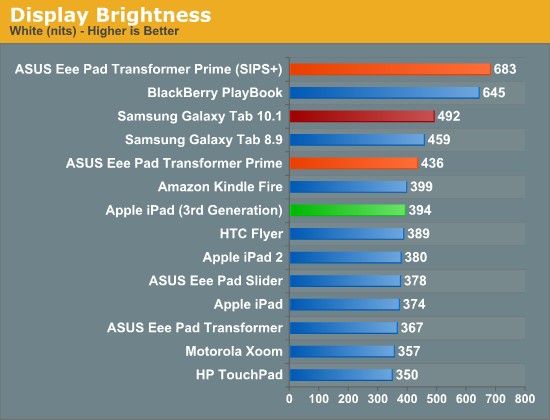
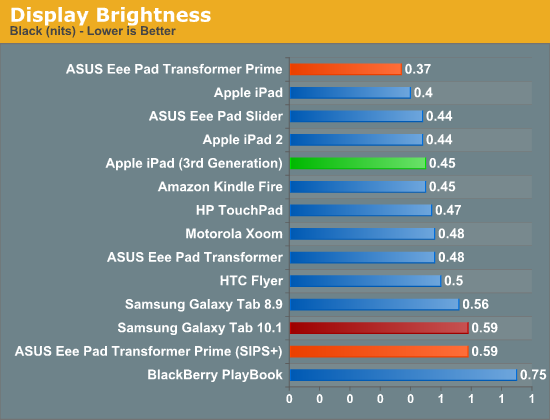
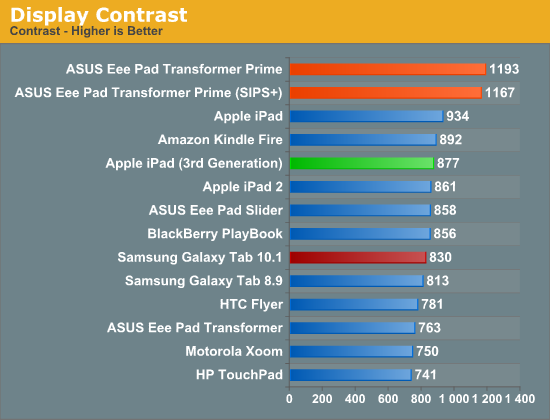
Apple is expected to have triple sourced panels for the new iPad, so you can expect to see variation in these results but for the most part you can expect the new iPad's display to perform similarly to the previous model.
Despite similar brightness and contrast to the previous model, the new iPad offers remarkably better color gamut and color reproduction than its predecessor. Relative to other tablets, the iPad's display is spectacular.
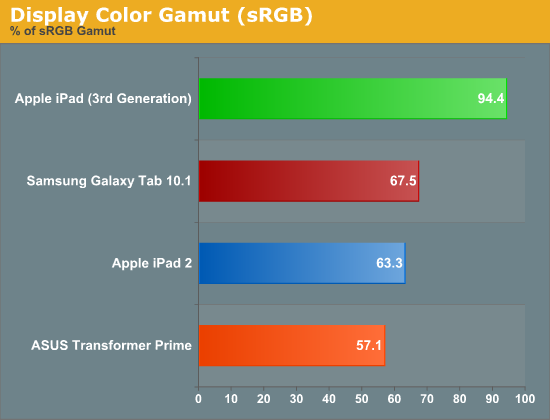
As we mentioned in our Retina Display analysis, Apple delivered on its claims of a 44% increase in color gamut. The new iPad offers nearly full coverage of the sRGB color space and over 60% of the Adobe RGB gamut:
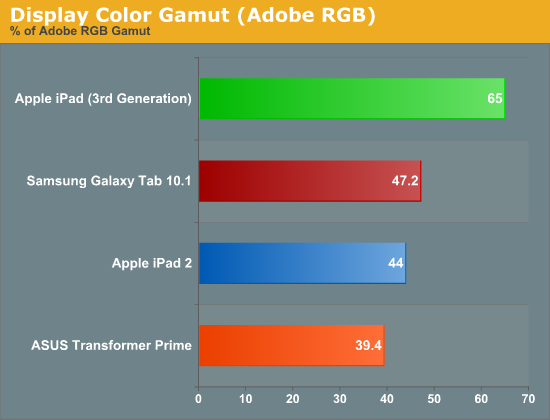
Below is the CIE diagram for the new panel with an sRGB reference plotted on the same chart so you can visualize the data another way:
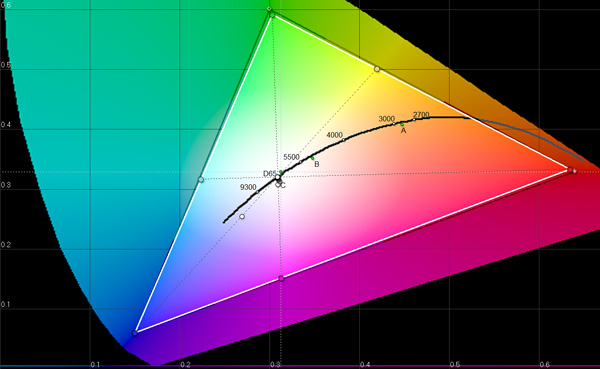
Color accuracy has improved tremendously if we look at delta E values for the primary and secondary colors:
Remember from our display reviews, lower delta E values indicate greater color accuracy. Values below 4 are typically considered good and you can see that the iPad 2 as well as the Transformer Prime both fell short in this department. With the new iPad Apple has clearly focused on color accuracy, which makes sense given it was used as the vehicle to introduce iPhoto for iOS.
Apple still has a lot of work ahead of itself to really put forth a professional quality display in a tablet, but for now the Retina Display is easily the best we've seen in a tablet and a tremendous step forward.
What's most absurd about the iPad's Retina Display is that you're able to get this resolution and panel quality in a $499 device. While we must be careful not to give Apple too much credit here as Samsung, Sharp and its other display partners clearly make the Retina Display, it's obvious that Apple has really been pushing its partners to develop solutions like this.
The biggest problem in the production of any commoditized component is the primary motivation for innovation is to lower cost. For years I argued with notebook PC makers to use higher quality LCD panels but no one was willing to commit to the quantities that would lower costs enough. I was also told that as soon as you put these notebooks on shelves at Best Buy, users wouldn't really care whether they were getting a high quality IPS display or not—all that mattered was the final price.
Apple, under the leadership of Steve Jobs, had a different mentality. Steve's pursuit was quality and experience, cost was a secondary concern. Through slow and steady iteration of this approach, Apple was able to build up a large enough customer base and revenue to be a significant force in the industry when it came to driving costs down. Apple can easily fill your fabs and eat all that you can produce, but you'll have to do whatever it wants to get the order.
Apple's behavior since it got rich has been to drive down the cost of higher quality components, LCDs being a perfect example. Unfortunately other companies don't benefit as much here as Apple tends to buy up all of the production of what it has pushed to create. That's one reason why, although ASUS was first to introduce a 1080p Transformer Pad, it won't launch until well after the new iPad. From what I've heard, the panel makers are all busy servicing Apple's needs—everyone else comes second.
Eventually the entire industry will benefit and all indications point to Apple doing something special for "pro" users in the notebook space next. As I've said previously, Apple has raised the bar with the iPad's Retina Display. The time for average display quality in a $500 tablet is over, the bar has been raised. It remains to be seen whether or not Apple will be able to maintain this quality across all suppliers of its Retina Display. On the iPhone Apple has been entirely too lax about maintaining consistency between suppliers. If it wants to be taken seriously in this space Apple needs to ensure a consistent experience across all of its component vendors.

















234 Comments
View All Comments
kwamayze - Friday, March 30, 2012 - link
WOW!!! What a nice review!!! Well donemichalkaznowski - Saturday, March 31, 2012 - link
Just to say as always a brilliant view. Your site is a must view for any enthusiast here in the UK. I also have appreciated your wireless router reviews of the Airport Extreme Base Station. Only you have pointed out that it has a quantum leap stability when compared to other makes of routers, something that a group of us have had to find out a very hard, frustrating and long way!Michal
x0rg - Saturday, March 31, 2012 - link
I have a suggestion. Instead of taking pictures you could take screenshots of these devices when you show how beautiful the screen is while working with Remote Desktop. Pictures taken with the camera look terrible and the whole concept of taking pictures instead of screenshots seems unprofessional for the portal like AnandTech. Things like focus, gamma, apperture are not affecting the picture quality when you just take a screenshot (Home+Power on iPad, you know that). Please replace these terrible pictures with screenshots. Thank you.slashbinslashbash - Sunday, April 1, 2012 - link
You missed the whole point of that part of the review. The point of the photos was to show that the text over Remote Desktop is actually readable in real-world use. A screenshot wouldn't convey that information.Imagine this. Say you took an iPhone 4 screenshot of the same scene in Remote Desktop, and you posted it on the site. This would be a 640x960 pixel image. Text would be readable on a desktop monitor, but it would probably not be readable on the actual 3.5" iPhone screen. That is the question, and it applies equally to the iPad3 review. A screenshot just shows you what pixels the iPad is showing; a photo shows you how those pixels look in real-life.
x0rg - Thursday, April 5, 2012 - link
I agree, my bad.TekFanChris - Sunday, April 1, 2012 - link
Thank you Anand and Vivek! You guys always take the iPad reviews to the next level. Comprehensive and complete.Cheers.
Death666Angel - Monday, April 2, 2012 - link
That kinda reminded me of the PS2 vs PC quality back in the days. :Djosemonmaliakal - Monday, April 2, 2012 - link
Hi Your article seems be so good . And i have got something about the upcoming iPhone 5 of Apple here @ http://wp.me/p2gN9B-lqWardawg - Thursday, April 5, 2012 - link
You forget the new iPad just came out 95% of the apps have not upgraded for the new retina display yet. So all of these comparisons are very inaccurate. It doesn't matter that the iPad has higher res and 3.1 million pixels if the app isn't upgraded for retina display it won't display as such you would expect. I expect you guys to make a new article soon fixing these concerns of mine with this article.Noobuser45 - Monday, April 9, 2012 - link
Anand, you're the only tech expert that I trust so I would love to have my mind put at ease with a definitive answer from you. Is it fine to charge the iPad whenever you want? Can I charge without running it down first? Can I charge for a while and unplug it before it has reached a full charge? Can I use it while it's charging? I just don't want to screw up the battery life.